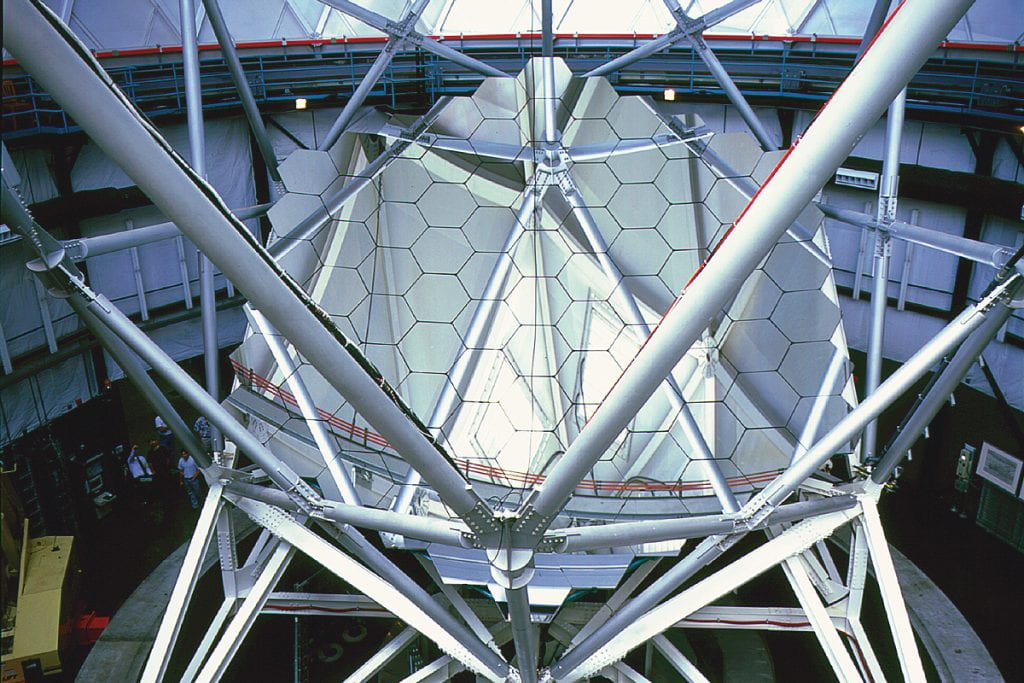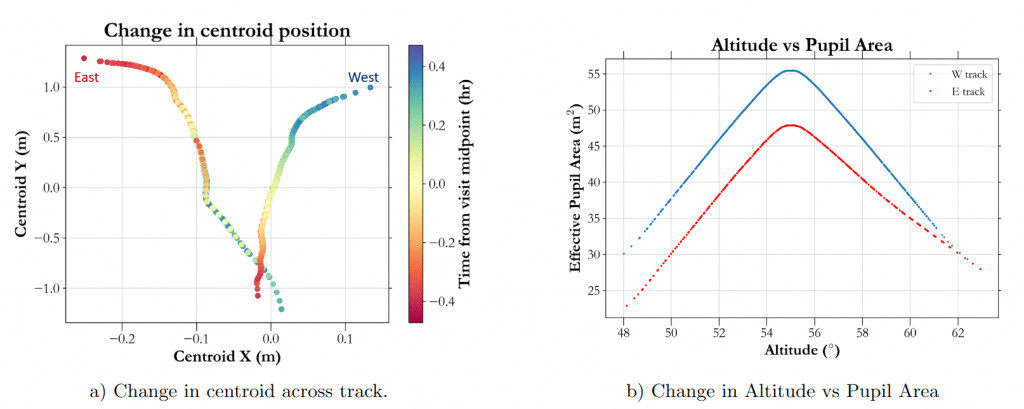Detection of small Earth like planets in the habitable-zones (HZ) of M dwarfs requires precise radial velocity measurements (RV) at the meter-per-second level. These extremely precise measurements are really hard! As the schematic below illustrates, they necessitate each step in the measurement process to be well understood and calibrated — the Earth’s atmosphere, the telescope, the fibers, the instrument, etc.
Achieving the exquisite RV precision that we have demonstrated on sky with HPF requires each of these sub-systems to work seamlessly. In this blog, we have discussed the performance of the some of these, with the detector, the extensive environmental control and stability, the optics, the calibrators. However, these systems together do not suffice to guarantee the level of RV precision required for HPF. One big factor external to the instrument is the telescope, the Hobby Eberly Telescope (HET).
Quick intro to the Hobby Eberly Telescope (HET)
The HET is one of the world’s largest optical telescopes, with a mirror that is 11 meters across. It consists of 91 hexagonal segments, each about 1 meter in size. The telescope was conceptualized by Larry Ramsey, an astronomer at Penn State (also a part of the HPF team) in the 1980s. However, unlike conventional observatories (which track objects in both altitude and azimuth), the HET primary mirror is fixed in altitude at about 55 degrees, and can only move in azimuth. Therefore, to track the object as the Earth rotates, the secondary mirror and corrective optics (situated in the prime focus instrument package; PFIP) move across the field of view of the primary.
Varying telescope pupil
The telescope focuses light into the HPF telescope fiber, as it tracks the star across the sky. However, the effective pupil projected by the combination of the telescope primary and PFIP on to the HPF fiber changes with time. In the movie clip below we show a simulation of the HET pupil changing across an observation (referred to as a track), where the circular pupil (green) moves across the hexagonal telescope primary (grey) and causes the centroid (red cross) to drift. The pupil of a telescope is the virtual image it forms, akin to the distribution in angular space. (Minor Aside: The pupil of a telescope is like the beam from a flash light that is incident on a far away surface. The nice circular angular distribution that is seen, is analogous to the pupil here.)
A change in the centroid coordinates with time can cause an artificial RV shift for HPF, which would correlate with the centroid coordinates, pupil area, and the object altitude. Therefore, the HPF team has developed a scrambling system which uses a 2 mm glass ball lens. This ball scrambler effectively decouples the spectrograph from input illumination changes, without losing too many precious photons. Read more about it in this paper.
In addition to the changing pupil area and centroid shown above, while observing certain objects in the sky, the telescope pupil is also obstructed by the a 28 meter tower, at azimuth ~ 68 degrees. This tower houses the center of curvature alignment sensor (CCAS), which is used to align the individual segments of the primary mirror into a perfect spherical mirror.

Left: An image of HET showing the dome housing the telescope, as well as the CCAS tower to the left of the dome. Credit: Marty Harris/McDonald Observatory. Right: Snapshots of the pupil viewing camera under afternoon sky illumination. The central obscuration with the PFIP, as well as the support trusses. Also visible are the fiber bundles on both sides of the central obscuration. The CCAS tower is visible in the top right image obscuring part of the pupil.
The combination of the central obscuration with the PFIP, support trusses, and the CCAS tower change the pupil as shown below.
But how does this affect the RVs?
In order to measure the effect of this changing illumination on the RVs, we need to track the RVs as a function of these telescope parameters that are changing with time. This requires a star that is bright enough to afford short exposure times. Luckily, one of the brightest M dwarf targets in the sky is visible from HET — GJ 411.
GJ 411 is the brightest M dwarf in the Northern Hemisphere, and is situated just about 2.5 parsecs (8 light years) from Earth. For comparison, the closest star Proxima Centauri is about 1.3 parsecs from us. This bright M dwarf is routinely observed by HPF, as part of its long term monitoring and engineering programs, with about 30 one-minute exposures during every visit. Across 43 such visits, we have about 1200 exposures on this object, which allow us to sample the RVs across a range of different centroid positions, pupil areas, and airmass. The plots below show how the centroid, and pupil area change with time and object altitude.
We then search for correlations between these GJ 411 RVs and these parameters, by combining the RVs across different visits. For example, the plot below shows the change in RVs as a function of altitude after combining the visits (for reference,the exposures across a single visit are shown in red).
So what do we find?
We look at the RVs as a function of different parameters, namely the centroid position, altitude, and also some environmental factors such as ambient temperature, humidity, pressure, seeing and sky brightness, and find no dependence. This places an upper limit on the scrambling performance of the ball scrambler used in HPF. We use the same ball scrambler system in HPF’s sister spectrograph – NEID, and also demonstrate the viability of this scrambling system for the upcoming generation of extreme precision radial velocity spectrographs aiming to find an Earth analogue in its Habitable zone.
You can read more about this work in this recent research article by HPF team member Shubham Kanodia.





 RSS - Posts
RSS - Posts